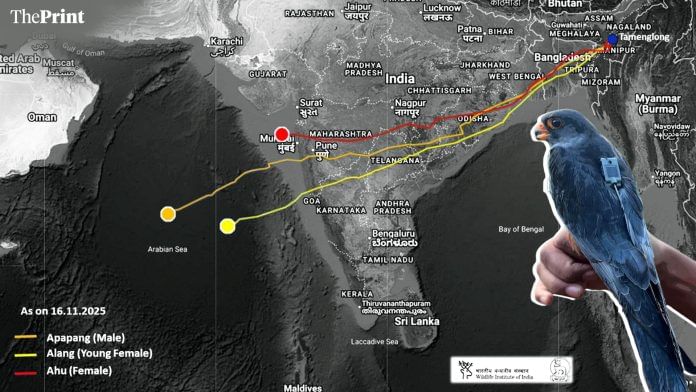Chennai: Three Amur falcons tagged in Manipur as part of an ongoing wildlife tracking project have completed their transoceanic migration to Somalia, covering nearly 5,000 kilometres in just over five days.
Two of the three birds—Apapang (adult male) and Alang (young female)—reached Somalia on 18 November, Wildlife Institute of India’s scientists, who have been monitoring their journey in real time under the Manipur Amur Falcon Tracking project, confirmed to ThePrint. The third bird—Ahu (adult female)—reached Wednesday morning Indian time.
Tamil Nadu Additional Chief Secretary for Environment, Climate Change & Forests Supriya Sahu, who has been sharing updates on social media, called their journey “breathtaking”.
“Woohoo… both Apapang and Alang have successfully crossed over, while Ahu is just about to reach… three Amurs, one breathtaking migration and a million people watching in awe,” she posted on X on Tuesday night.
Data shared by the WII showed that Apapang alone covered nearly 5,400 km in 5 days and 15 hours, flying almost 1,000 km a day, maintaining an uninterrupted pace across the Arabian Sea. Shortly after being tagged on 11 November, he travelled more than 3,000 km in just 76 hours, crossing central India before heading out over open water.
Supriya Sahu told ThePrint the migration follows patterns seen in previous tracking efforts.
“Last year, the Wildlife Institute of India tracked a bird that followed the same route — to Guinea and Somalia, where it stayed for about three months until Siberian conditions eased, before returning to Siberia and then back to India,” she said.
“This year, we are tracking three birds. It is fascinating and it’s truly a wonder of nature. They are following the same ancient routes with astonishing precision,” she added.
Dr Suresh from the Wildlife Institute of India, who leads the tracking project, said the Amur falcons’ behaviour and endurance are rooted in evolutionary survival strategies.
According to researchers at Wildlife Institute of India, migration of the birds is a natural survival strategy.
“Species like the Amur falcon move seasonally to escape harsh weather, find richer feeding grounds, or access suitable breeding habitats. Over evolutionary time, individuals that migrated survived better, which is why migration persists,” one of the researchers at the WII told ThePrint.
According to Supriya Sahu, tracking is crucial for identifying the precise routes the birds use, the environmental conditions influencing their flight, and the critical stopover sites they rely on.
“It also helps detect threats, from habitat loss to hunting, and offers insights into how climate change is altering migration patterns globally.” she told ThePrint.
As a lot of social media users asked Sahu where do these birds get the energy from to undertake this humongous nonstop flight, she just said, “Termites.”
“Those fat reserves from termites sustain them through the nonstop oceanic leg, where food and water are unavailable.” Supriya shared the insights from WII researcher Dr Suresh.
Dr Suresh of the WII said that before starting their transcontinental journey, the birds stop in Manipur and Nagaland, where their arrival coincides with the mass emergence of termites.
She also shared that the falcons cannot rest while crossing the sea since they are terrestrial. “Once they leave the Indian coast, they undertake a single uninterrupted flight across nearly 3,000 km of open sea.”
The Amur falcon’s journey was once threatened by widespread hunting during their stopovers in Northeast India. Community-led conservation efforts in Manipur and Nagaland have since transformed the landscape, with villagers now protecting the birds and celebrating their arrival as a symbol of coexistence and local pride.
With all three tagged falcons now safely in Somalia, researchers say their journey offers rare insights into one of the most extreme and compelling migrations in the natural world.
Meanwhile, Manipur’s Additional District Magistrate Noney has issued prohibitory orders to protect migratory Amur Falcons from 10 November.
The directive is to enforce a complete ban on hunting, killing and trading of the species and mandates all residents to surrender their airguns to village authorities until 30 November, when the birds’ migration from Manipur completes.
The order was issued based on the request from the forest department to prevent illegal hunting of the birds’ and ensure safe passage of the birds, researchers at WII told ThePrint.
(Edited by Ajeet Tiwari)
Also Read: Siberia to Mozambique via Manipur, how the Amur falcons traverse the world in search of warmth






